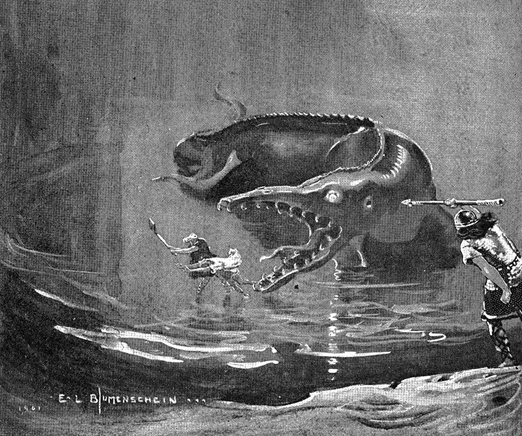David Meyer's Blog, page 16
July 17, 2012
Monsters, Ghosts, & UFOs: Protosciences…or Pseudosciences?
Monsters, ghosts, and UFOS may or may not exist. But fields of study devoted to these phenomena have sprung up over the last few decades. How should we classify cryptozoology, ghost hunting, and ufology? Are they protosciences (emerging areas of study)? Or are they pseudosciences?

“Hoding stood erect and whirled his axe up against the descending muzzle”
Illustration by E.L. Blumenschein for “Thyra: A Romance of the Polar Pit” by Robert Ames Bennet (1901)
Source: Project Gutenberg Australia
Background
For the last few months, we’ve been following numerous pseudoscientific expeditions that have received little coverage in the press (you can find our coverage of the Baltic Anomaly expeditions, TIGHAR’s Amelia Earhart expedition, and the Newmac Expedition at the bottom of this page). At the same time, we’re also considering mounting our own expedition.
As such, we’ve been trying to figure out how to conduct true “scientific investigations” in fields of study usually considered to be pseudosciences. Is it even possible? If so, how would one go about planning such an investigation?
This is a big topic so it will probably take us several articles to fully cover it. We’ll use this first article to present the problem and establish the importance of the scientific method in scientific research.
Superstitions to Science
There are five general ways people attempt to answer scientific questions. They range from superstitions to mainstream science.
Superstitions: Superstition is the linking of cause and effect using supernatural forces rather than natural science.
Pseudoscience: Pseudoscience refers to scientific-like ideas that fall short of actual science. Usually, research in these areas lacks evidence or the ability to duplicate experiments. As such, the scientific method is not properly employed.
Fringe Science: Fringe science employs the scientific method. However, it is highly speculative and its results are widely rejected within the general scientific community.
Protoscience: Protoscience also employs the scientific method. It refers to new areas of scientific investigation that have yet to be firmly established. Sometimes these areas fail to pan out and become pseudosciences or fringe sciences. Other times, such as with plate tectonics, they become widely accepted as mainstream sciences. Cryonics could be termed a current protoscience.
Mainstream Science: An established and respected field of scientific study.
The issue of what separates science from pseudoscience is known as the demarcation problem. This is actually a difficult problem and remains a point of contention among many researchers. Most scholars believe the scientific method must be utilized in true science. Karl Popper suggested that scientific statements must be falsifiable, or capable of being refuted by a physical experiment.
Arguably, falsification is required when making proper use of the scientific method. Thus, for our purposes, we’ll postulate that true science requires the ability to test hypotheses using the scientific method.
The Importance of the Scientific Method
The scientific method is a self-correcting body of techniques used to gain knowledge. While there isn’t an established procedure, there are several steps which are generally utilized by the scientific community. Here’s one possible iteration of these steps.
Observe phenomena.
Define a question about the phenomena.
Form a testable hypothesis answering the question.
Rigorously test the hypothesis in ways that can be repeated.
Analyze the data.
Either reject or don’t reject the hypothesis (note: not rejecting the hypothesis doesn’t mean accepting it). If hypothesis is rejected, form a new hypothesis and repeat steps 3-6.
Publish results so others can peer-review the work.
Good science isn’t about proclaiming a hypothesis to be fact. Rather, it’s about doing everything you can to refute your own hypothesis. This requires creating unique and creative tests in order to rule out alternative theories. But even if these tests are done in a comprehensive fashion, an unassailed hypothesis still isn’t fact. It merely hasn’t been refuted yet. It might hold up under thousands of different tests. But all it takes is one test to send it to the dustbin of history.
“Science is about trying to prove that you’re wrong and then sort of grudgingly accepting that you haven’t been able to prove yourself wrong.” ~ Gary Taubes, Q&A with Gary Taubes
Monsters, Ghosts, & UFOs
Crytozoology, ghost hunting, and ufology are devoted to the study of unknown animals (or cryptids), ghosts, and UFOs, respectively. Practitioners tend to think of themselves as scientists. They’ve even adopted many scientific practices. They use scientific jargon and employ technical equipment in the field. Many researchers join organizations and publish research papers. To the casual observer, it all looks very scientific. Unfortunately, it’s often not even close.
Many researchers in these fields are hopelessly biased. A proper scientific investigation attempts to explain phenomena with hypotheses based on the most logical explanations. Then scientists attempt to refute those hypotheses. However, pseudoscientists often do the exact opposite. They establish pseudoscientific hypotheses and then marshal evidence to support their own hypotheses. Incidentally, we accused TIGHAR of doing this exact same thing recently while searching for Amelia Earhart’s lost Lockheed Electra.
The presence of poor researchers is unfortunate. However, it doesn’t necessarily discredit these fields of study. Can crytozoology, ghost hunting, and ufology be practiced as real protosciences as opposed to pseudosciences?
Guerrilla Explorer’s Take
Well, that’s it for today. In summary, we believe true science (protoscience and mainstream science) requires its practitioners to make rigorous use of the scientific method. Most cryptozoologists, ghost hunters, and ufologists appear to fail that test. But is that just due to the individuals themselves? Or are these fields of study doomed by their very nature? We’ll take a closer look at that issue tomorrow.
Guerrilla Explorer’s Coverage of Monsters, Ghosts, & UFOS: Sciences or Pseudosciences?
7/17/12: Monsters, Ghosts, & UFOs: Protosciences…or Pseudosciences?
7/18/12: Monsters, Ghosts, & UFOs vs. Science: Part II?
7/22/12: Monsters, Ghosts, & UFOs: A Paradigm Shift?
7/23/12: Monsters, Ghosts, & UFOs: Conducting Pseudoscience?
No related posts.
The post Monsters, Ghosts, & UFOs: Protosciences…or Pseudosciences? appeared first on Guerrilla Explorer.

July 16, 2012
The Baltic Anomaly: The Fire and Ice Theory?
The strange Baltic Anomaly has baffled the world for over a year. Recently, the Ocean X Team returned to the Anomaly in order a conduct a new investigation, spurring renewed rumors and speculations in the process. But what is it? Is it something artificial? Or is it a natural formation made from…fire and ice?

“Pillow lava rocks on the slope off Hawaii form when magma oozes from below.”
July 1988
Source: National Oceanic and Atmospheric Administration/Department of Commerce & OAR/National Undersea Research Program (NURP)
The Baltic Anomaly
On June 19, 2011, the Ocean X Team used side-scan sonar to “photograph” a massive object deep in the Baltic Sea, approximately 260 feet below surface. Peter Lindberg, co-founder of the Ocean X Team, jokingly declared “Hey guys, we have a UFO!” However, after a new expedition, the Team discovered the Anomaly primarily consisted of large rocks. The exact nature of those rocks, which we call the Circle, as well as a 985 foot runway leading up to them (the Tracks), remain mysteries.
Since that time, the Ocean X Team has gone on a second expedition, released a few photographs and some video, and provided lots of mysterious information via interviews conducted primarily with the Team’s UFO-centric Facebook community as well as websites devoted to UFOs. However, very little concrete data has emerged. Skeptics, including us, have questioned whether or not the Baltic Anomaly is a “hoax” of sorts.
The Ocean X Team has vigorously defended itself from charges of a hoax. They claim to be ordinary treasure hunters who happened to stumble upon a strange mystery. They have assured the world that they want answers just as badly as everyone else.
Outstanding Physical Mysteries?
Let’s get one thing straight…the Baltic Anomaly “evidence” available to the public is quite limited and of very poor quality. Most of the information is in the form of unsubstantiated testimony. Unfortunately, some of this testimony has changed over time (for example, the mysterious “egg shaped” hole is now referred to as a perfectly round hole). Other pieces of this testimony are highly speculative, such as reports of malfunctioning equipment and other odd phenomena. That being said, here are a few of the “physical mysteries” surrounding the Baltic Anomaly.
Strange Shapes: One end of the Circle has a rounded, circular shape. The top of the Circle contains numerous right angles and carved pathways which apparently resemble the shapes of “corridors,” “rooms,” and even a “staircase.
“The Hole: There is a hole on top of the Circle. In its initial statement, the Ocean X Team described it as “egg shaped.” More recently, Peter Lindberg, co-founder of the Ocean X Team, referred to it as “round.
The Fireplaces: The Team photographed several circular rock formations on top of the circle which resembled “small fireplaces.” The stones were covered with something that looked like soot. Stefan Hogeborn, one of the divers, described them as being “like four or five pearl necklaces with stones, each a few decimeters in diameter.” For reference, a decimeter is equal to roughly four inches.
Mysterious Stone Samples: The Team collected two stones from the area. One of the stones was apparently indigenous to the region but normally found under the Earth’s crust. The other stone was common to the mid-Atlantic.
Odd Materials: The Circle’s exterior was initially described as resembling sandstone. Lately, it has been described as “granite.” When divers broke off a piece, they discovered the inside was black, like volcanic rock.
Volcanic Activity: No known volcanoes exist in the Baltic Sea. However, the Team spotted a 50-meter tall mountain that resembles a “black smoker” several miles from the Circle. The Ocean X Team also believes magma resides underneath the Circle and in the vicinity.
Fire & Ice
There are well over a dozen theories by now which attempt to explain the Baltic Anomaly. They range from the natural (pillow lava, rock formation) to the artificial (a shipwreck, an artifact of an ancient civilization, a forgotten Nazi sub trap, and even a sunken UFO).
We’ve gone on record stating our opinion that the Circle may have been formed by several extinguished “black smokers.” We’ve also pointed out how the last Ice Age could’ve formed the “small fireplaces.” However, we haven’t really taken the time to put these pieces together into one comprehensive theory. So, here it goes…we believe the Circle was formed by “fire and ice.”
We are currently in an ice age, known as the Pliocene-Quaternary glaciation. It started 2.58 million years ago. During this period, ice sheets have advanced and retreated on a cyclical basis. To make a long story short, the area now encompassed by the Baltic Sea was heavily eroded during these cycles, eventually forming a deep basin.
While covered in ice, we believe a sort of subglacial submarine eruption took place in the area now encompassed by the Baltic Anomaly. This could’ve been accomplished via now-extinguished hydrothermal vents or via a normal submarine eruption.
Magma and/or dissolved minerals was expelled into the thick ice sheet. It was hot enough to melt out space underneath the ice. However, it wasn’t hot enough to melt a hole through it. Thus, a large subglacial mound formation known as pillow lava was created. The video below, from the movie “Pele Meets the Sea,” shows pillow lava flowing underwater off Hawaii’s coast. This particular lava erupted on land and flowed into the ocean. However, underwater pillow lava probably forms in a similar manner.
And that’s it. In other words, we think the Baltic Anomaly is most likely an ancient pillow lava formation, created by the interaction of fire and ice.
Back to the Outstanding Mysteries…
But how does the “fire and ice” theory hold up to some of the outstanding mysteries we listed above? Let’s take a look…
Strange Shapes: According to the Encyclopedia of Volcanoes, “the glassy surfaces of pillows are not smooth but have cracks, corrugations, and linear grooves, many of which intersect at right angles.” Also, lava pillows “are found in a wide variety of shapes including near-spherical bulbous pillows.”
The Hole: This could be the remains of an extinguished hydrothermal vent. Also, sometimes lava “pushes aside a portion of the outer pillow crust and drains out through the hole to form a spilled pool outside the broken pillow.”
The Fireplaces: The “fireplaces” might actually constitute moraines. In other words, as the ice sheets retreated from the pillow lava, small rocks slid down a cone of ice to form a circular shape on top of it.
Mysterious Stone Samples: The stone normally found under the Earth’s crust could’ve been driven to the surface by the submarine eruption. The other stone could’ve arrived in the area via any number of normal means.
Odd Materials: The chipped, granite-like surface of the Circle is consistent with what one would expect to find at a pillow lava formation. Also, the black interior could be explained by a heavy presence of sulfide. Incidentally, sulfide would also explain the substance “resembling soot” which covered the rocks dotting the exterior.
Volcanic Activity: The 50-meter tall mountain resembling a “black smoker” indicates the presence of volcanic activity in the region. Also, although no known volcanoes exist in the Baltic Sea, geothermal heat is actually fairly common. Regardless, if the “fire and ice” theory is correct, the volcano or black smoker would’ve existed thousands of years ago when ice lasted covered the Baltic Sea.
Guerrilla Explorer’s Take
So, there you have it. Unfortunately, the lack of concrete information makes it difficult to provide much in the way of extensive analysis. However, the “fire and ice” theory appears to explain most of the outstanding physical mysteries surrounding the Circle.
The Ocean X Team is currently on-site, investigating the Anomaly. They are expected to return in late July.
Guerrilla Explorer’s Coverage of the Baltic Anomaly
1/30/12: A Lost Shipwreck…or a Lost UFO?
6/2/12: The Baltic Anomaly?
6/6/12: The Baltic Anomaly: UFO…or just a Hot Spring?
6/8/12: The Baltic Anomaly: A New Discovery?
6/12/12: The Baltic Anomaly: Is it a Hoax?
6/13/12: The Baltic Anomaly: Another “Great Lakes Hoax”?
6/14/12: The Baltic Anomaly: The Lost Updates?
6/15/12: The Baltic Anomaly: Answers at Last?
6/16/12: The Baltic Anomaly: Questions & Speculation?
6/17/12: The Baltic Anomaly: What is Going on Here?
6/18/12: The Baltic Anomaly: The Bigger Picture?
6/19/12: The Baltic Anomaly: Is it a Black Smoker?
6/20/12: The Baltic Anomaly: That Mysterious Pillar?
6/21/12: The Baltic Anomaly: The Nazi Connection?
6/22/12: The Baltic Anomaly: The Ocean X Team Speaks!
6/23/12: The Baltic Anomaly: What is the next “Anomaly”?
6/27/12: The Baltic Anomaly: Is it Natural…or Artificial?
6/28/12: Breaking News: Is the Baltic Anomaly an Elaborate Hoax?
7/2/12: The Baltic Anomaly: What is the Secret Wreck?
7/6/12: The Baltic Anomaly: The Original Ocean X Team?
7/16/12: The Baltic Anomaly: The Fire and Ice Theory?
Related posts:
The Baltic Anomaly: That Mysterious Pillar?
The Baltic Anomaly: Answers at Last?
Breaking News! Is the Baltic Anomaly an Elaborate Hoax?
The post The Baltic Anomaly: The Fire and Ice Theory? appeared first on Guerrilla Explorer.

July 15, 2012
The Statue of Liberty in 350 Pieces?
The Statue of Liberty, complete with pedestal, stands about 305 feet tall. It resides on Liberty Island in New York City. However, it wasn’t always that way. What did the Statue of Liberty look like before completion?

“Workmen constructing the Statue of Liberty in Bartholdi’s Parisian warehouse workshop; first model; left hand; and quarter-size head”
Photographer: Albert Fernique, Winter 1882?
Source: Library of Congress Prints and Photographs Division
The Statue of Liberty?
The Statue of Liberty was conceived by Frédéric Bartholdi in 1867. Construction started in late 1875. Originally, it was supposed to be completed by 1876, in time for the 100th anniversary of the signing of the Declaration of Independence. However, funding was short and the project became somewhat of a boondoggle. As such, the statue’s completion was delayed until June 1884.
By 1885, funding for the pedestal had dried up as well. Governor Grover Cleveland (who would later serve as the 22nd and 24th President of the United States) vetoed a bill to contribute $50,000 of New York’s taxpayer dollars to the project. A similar bill, this time for $100,000, failed to pass Congress. Finally, Joseph Pulitzer, publisher of the New York World, initiated a fundraising project and ultimately raised $102,000 from 120,000 donors, 80% of whom sent less than a dollar apiece.
With these new funds, work was completed. Afterward, workers broke it down into 350 pieces and shipped it to America. It was officially dedicated on October 28, 1886 by newly elected President Grover Cleveland. Below, you can see some pictures of the Statue of Liberty during the construction process and at the inauguration, courtesy of the Library of Congress. Enjoy!

“Colossal hand and torch ‘Liberty’”
Centennial Photographic Co. – 1876 Centennial Exhibition in Philadelphia.
Source: Library of Congress Prints and Photographs Division

“Head of Statue of Liberty on display in park in Paris”
Photographer: Albert Fernique, 1883
Source: Library of Congress Prints and Photographs Division

“Liberty enlightening the world–Inauguration of the Bartholdi Statue, Harbor of New York–Military and naval salute, the President’s arrival at Liberty Island”
October 28, 1886 (published in 1887)
Source: Library of Congress Prints and Photographs Division
Related posts:
The Mysterious “Weeping” Statue of Jesus?
The Lost Declaration of Independence?
The Dinosaur Expedition Disintegrates?
The post The Statue of Liberty in 350 Pieces? appeared first on Guerrilla Explorer.

July 14, 2012
The Dinosaur Expedition Disintegrates?
Several weeks ago, the Newmac Expedition traveled to the Republic of Congo. Among other things, they sought to investigate the legendary mokele-mbembe, believed by some to be the last living dinosaur. But now, the expedition appears to have hit a major snag. Is this the end of the Newmac Expedition?

Dinosaur Skeleton
Photographer: Harris & Ewing (1913-1917)
Source: Library of Congress Prints and Photographs Division
The Hunt for Mokele-mbembe?
The Newmac Expedition used Kickstarter to raise $28,925 from 750 backers in order to categorize “plant and animal species in the vastly unexplored Republic of the Congo.” They describe the Congo Basin as “a region of Central Africa larger than the state of Florida, more than 80% of which has been totally unexplored.”
Most of the publicity surrounding the Newmac Expedition has been centered on its interest in a strange creature known as mokele-mbembe. The mokele-mbembe, or “one who stops the flow of rivers,” is a mythological creature supposedly residing in the swamps of the Congo River Basin. Details vary but most descriptions refer to it as having a long neck, a long tail, and a relatively small head. Some cryptozoologists speculate it might be a sauropod…in other words, a dinosaur.
What’s New?
The Expedition launched on June 26. Three days later, it suffered a major blow when Joe Marrero “decided to completely withdraw from the Newmac Expedition.”
“I am disappointed on how the expedition was managed and found it necessary to severe my involvement in the expedition. I wish Stephen and Sam the best of luck on their adventure.” ~ Joe Marrero
The remaining members of the Expedition noted his departure over twitter.
“Joe Marrero has withdrawn from the expedition. We wish him the best on his future adventures.” ~ Newmac Expedition, July 10
As best as we can tell, the Newmac Expedition started out with five principals. According to their website, they are now down to three.
Guerrilla Explorer’s Take
Obviously, we don’t know the full story behind this situation. But the loss of a principal is no small matter. Unfortunately, this doesn’t bode well for the Newmac Expedition. This whole thing is starting to look exactly like what critics claimed it would be…a poorly-planned and perhaps ill-conceived operation. We’ll continue to follow this story as best we can but for now, the future of the Newmac Expedition appears to be in doubt.
Guerrilla Explorer’s Coverage of the Newmac Expedition
6/23/12: The Baltic Anomaly: What is the next “Anomaly”?
6/24/12: The Search for the Last Dinosaur?
6/25/12: The Newmac Expedition: What is the Mokele-Mbembe?
7/14/12: The Dinosaur Expedition Disintegrates?
7/19/12: The Dinosaur Expedition goes…Extinct?
No related posts.
The post The Dinosaur Expedition Disintegrates? appeared first on Guerrilla Explorer.




